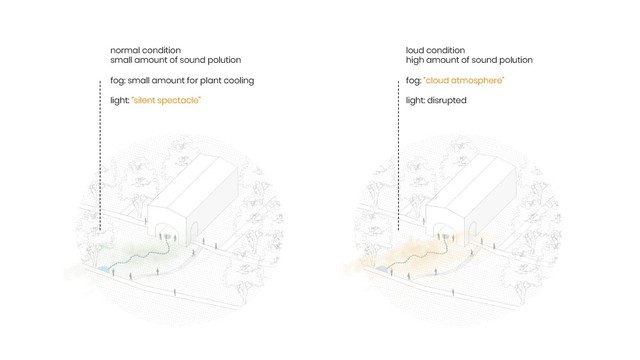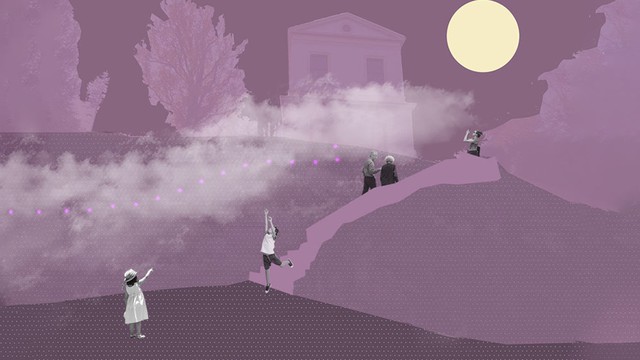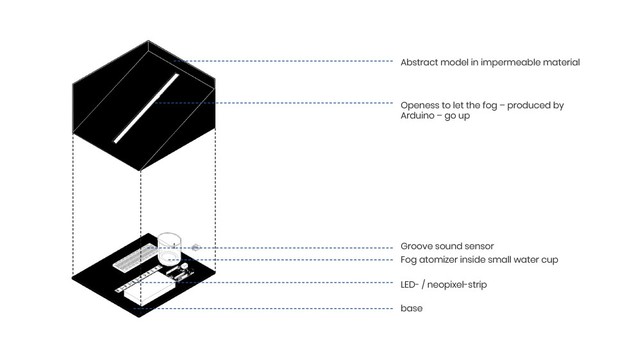_silent spectacle 2021, Germany, Weimar
a [noise] pollution data driven instalation







The installation "silent spectacle" at the “Park a der Ilm'' in Weimar proposes a new relationship with nature, in which humans and nature co-live in balance. By converting natural data input of the park into a visible and interactive installation, it creates a new possible space for civic engagement and increment of human impact awareness. By addressing the problem of [noise pollution ]in the project area, the Roman-House-Hill, the installation materializes this pollution by making it viewable through fog and light. The levels of this are controlled by the sound pollution created by the park pedestrians, creating an interactive space while also establishing a new nature atmosphere, in which humans and nature co-live in balance. It proposes a space where humans can realize their impact and distance themselves from our exploratory relation with nature.
To achieve that, it turns the natural data input of the park into a visible and interactive installation. In the project area, the Roman-House-Hill, a large difference in noise levels was observed at different points. The hill acts as a sound barrier, blocking the city's sound pollution. [Noise] pollution can deeply impact a balanced ecosystem, yet this problem is normally overviewed since it’s not tangible in daily life. Our project wants to show the invisible effects of noise pollution by making it viewable through fog and light. The amount of fog and light will be directly corresponding to the amount of sound pollution at the Roman-House-Hill, making the association clear to pedestrians. While the fog creates an ephemeral and romantic atmosphere, the light gives a playful and direct response to human impact. In addition to proposing this new relationship with nature, "silent spectacle" proposes a response to the problem of global warming as it creates a cool atmosphere for the plants that are already suffering from heatwaves. "Silent spectacle" as-a-result is an interactive installation that returns something to nature and at the same time makes the human impact on the environment visible.
Poster
Details
Team members : Paola Bonetto Ferrari, Patricia Berchtold
Supervisor : Advisor: Dr.-Ing. Sabine Zierold
Institution : Bauhaus University Weimar
Descriptions
Technical Concept : The development of the project focused on defining two technical scales: the real life-scale and the prototype scale. Each one focused on the available devices, materials, and technical support at the time. For the real installation, it was proposed a string system controlled by .java code to produce the fog and light, driven by the [sound pollution] income. It's formed by ultra-fine mist fog nozzles, LED RGB strings, and intermediate materials to impermeabilize. The fog nozzle system is inspired by a two-fluid mist nozzle solution to create a fine dry water mist. The use of live data sensors creates responsiveness, reacts to the sound pollution, while also measures the local humidity to adjust the fog for the plants. The prototype scale tested these components and the code. The components, such as the sound sensor, fog atomizer, LED string, and Arduino are located inside of it.
Visual Concept : The final concept of “silent spectacle” connects the pre-existing water sources of the Roman House: the fountain on top of the hill and the water pond on the bottom. A line of fog-nozzles creates a cooling effect for both nature and humans. The combined LED-line forms a direct sound response and invites the pedestrians to stop and re-evaluate their own emission of sound pollution. The ephemeral atmosphere created by the fog proposes a new relationship with the park, while also resembling the Ilm Park Landscape Design, romantic, humanistic, and ethereal. This historical connection seeks to create an installation that is deeply connected within the context and creates new spatial qualities without impacting physically on the natural context. The fog acts as an ephemeral architecture while also acting as an informational data-driven installation.
Credits
Paola Ferrari & Patricia Berchtold
Paola Ferrari & Patricia Berchtold
Paola Ferrari & Patricia Berchtold
Paola Ferrari & Patricia Berchtold
Paola Ferrari & Patricia Berchtold
Paola Ferrari & Patricia Berchtold
Paola Ferrari & Patricia Berchtold
Paola Ferrari & Patricia Berchtold
Paola Ferrari & Patricia Berchtold